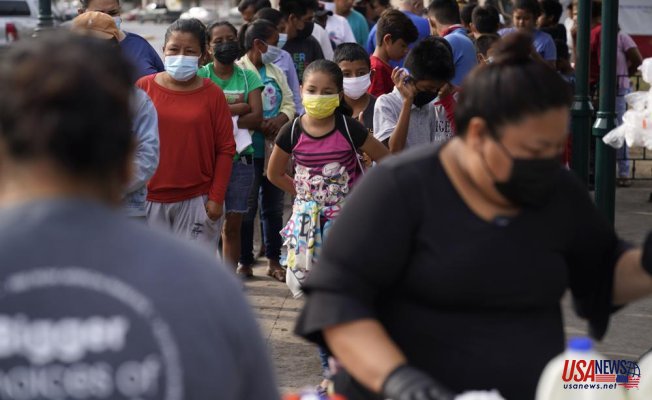TIJUANA (Mexico) -- In the darkness, 250 officers and workers from cities rushed into a camp for migrants looking to apply for asylum in America. The migrants had to either register for credentials or flee. Within hours, the chain-link fence extended to twice the height of Liberty's Statue of Liberty.
The Oct. 28 operation could have been the end of a camp that used to hold about 2,000 people, and blocked a major border crossing with the United States. There could be many more camps.
Jill Biden, the first lady, sharply criticised a Matamoros camp bordering Brownsville in Texas on a 2019 trip. She said, "It is not who we as Americans are." Other camps sprung up in Tijuana and nearby Reynosa around the same period.
These camps are full of children and result from policies that make migrants wait in Mexico to be heard in U.S. immigration courts or prevent them from applying for asylum under pandemic related public health powers. The growing number of migrants in Mexico's border cities has led to increased uncertainty about U.S. asylum policies, which created the conditions for further camps.
While migrants are rarely visible in border cities, the Tijuana camp makes them highly visible and disruptive. Tents with blue tarps and plastic bags blocking entry to the border crossing block the flow of people. This is where approximately 12,000 people entered the U.S. each day before the pandemic. It is one of three pedestrian crossings that lead to San Diego.
November 8th, the U.S. completely reopened its borders with Mexico and Canada for vaccinated travelers.
Montserrat Caballero was Tijuana’s first female mayor. She said that officials did "almost nothing to control the camp" before she assumed office on Oct. 1. She asked Mexico's federal and state governments to help her erect a fence and establish a registry but they declined.
She said that authorities at all levels were afraid of making mistakes, fear of making something wrong and having an impact on their political careers. These are difficult issues to tackle.
Caballero claimed she was protecting migrants. Caballero said she does not know of any homicides or kidnappings at Camp, but The Associated Press discovered that there have been numerous assaults, drug use, and threats.
She said, "I couldn't close my eyes to the flashing light I saw." It is best to close your eyes and let it grow.
Tijuana police guard the only exit point. The only restriction is that migrants with valid credentials can enter and leave the country.
Enrique Lucero (the city's director for migrant services), stated that there is no asylum process in the United States until further notice. He spoke to people on a morning walkthrough last week who wanted to know more about U.S. policies.
Title 42 is a US law that allows adults and their families to be expelled without the possibility of asylum. Unaccompanied children are exempted from this ban. The Biden administration only has that authority over about one in four families who arrive, due to Mexico's unwillingness to return Central American families and resource limitations.
It is not clear why the U.S. allows many families to seek asylum, but it also returns other families to Mexico. This prompts those who are turned away to stay put until they succeed.
Mayra Funes (28-year old Honduran) said that she wasn't allowed to present her case to agents after she was expelled from crossing the border illegally near McAllen in Texas with her 7-yearold daughter. After six months in Tijuana, she doesn't know whether she will attempt again.
She stated that there is no way to know how they will open the process.
Lucero is a soft-spoken graduate from George Washington University and worked at the Mexican consulate, Chicago. He says that his job is to persuade migrants to seek shelter. Large facilities have been opened recently by the federal and state governments of Mexico. Many feel intimidated by curfews, shelter rules, and fear that being further from the border will mean they are not able to receive news about U.S. policy developments.
Natalina Nazario (37), didn't need convincing. She stopped Lucero and accepted the offer of the city to pay for a bus ticket to Acapulco. It is 1,900 miles (3.040 km) from her home. Although she fears violence in Mexico's beach city, she doesn't want her kids to miss more school after spending a month at the camp.
Lucero was not noticed by many others. Olga Galicia (23-year-old Guatemalan woman) sat down on a curb, washing clothes with soapy water and scrubbing them. She said that she had been at the camp for six months.
Caballero said that Tijuana will not forcibly expel any migrants. He expects the seasonal rains to allow holdouts to flee. Many migrants arrived in a caravan in 2018 and were left wet from the cold November rains.
According to the city, the camp housed 1,700 people in the two weeks prior to the Oct. 28 operation. Caballero had publicly warned of the coming operation but did not specify when.
On Oct. 29, 769 migrants were counted, with more than 40% of them children. The majority of the migrants were Mexican, many from Guerrero and Michoacan, and one-third were Hondurans. El Salvadorans and Guatemalans account for almost all of the remainder.
Caballero stated that the steep decline in registration numbers likely indicates that there were many Tijuana homeless people living there, and not migrants.
The camp is located on a large, once barren area. The warren of walkways is made up rows that are large enough to allow two people to walk in opposite directions. People can relax in tents, or out on the ground in folding chairs.
There are 10 portable bathrooms and 12 showers, as well as a shared water tap to wash clothes. Hot chocolate, hot dogs, and spaghetti are prepared by charities that donate food to migrants. Recently, the federal utility stopped the camp stealing electricity. This left it dark at night, and forced the makeshift kitchen to use canned food.
Reynosa's migrant camp, which is located across the border from McAllen Texas, has less certainty of its future. Felicia Rangel–Samponaro, the director of The Sidewalk School which educates children, stated that there are approximately 2,000 people living in a square near the main crossing.
A court order has ordered the Biden administration to immediately reinstate a Trump-era policy that made asylum seekers wait in Mexico until they can be heard in the U.S. The Trump-era policy had allowed them to deport people seeking asylum. The approval of Mexican officials is required. They have indicated to the U.S. that they need more shelter beds, and are concerned about violence in Reynosa, the state of Tamaulipas.
Blas Nunez Nieto, acting assistant U.S. diplomat, said that the "Remain in Mexico” policy will resume within "the coming weeks" if U.S. authorities and Mexican authorities have resolved "one set of outstanding problems." In a court filing, Monday's Homeland Security secretary for immigration and border security stated this. He didn't elaborate.
Caballero stated that the U.S. authorities aren't pressuring Mexico to reopen the pedestrian crossing between Tijuana, San Diego. U.S. Customs and Border Protection stated in a statement that it was working closely with Mexico to determine how normal travel can be resumed safely and sustainably.
The mayor will ask Mexico's National Guard for help to prevent new camps from appearing in Tijuana.
She stated, "The truth is that camps will be established if you are not prepared."












